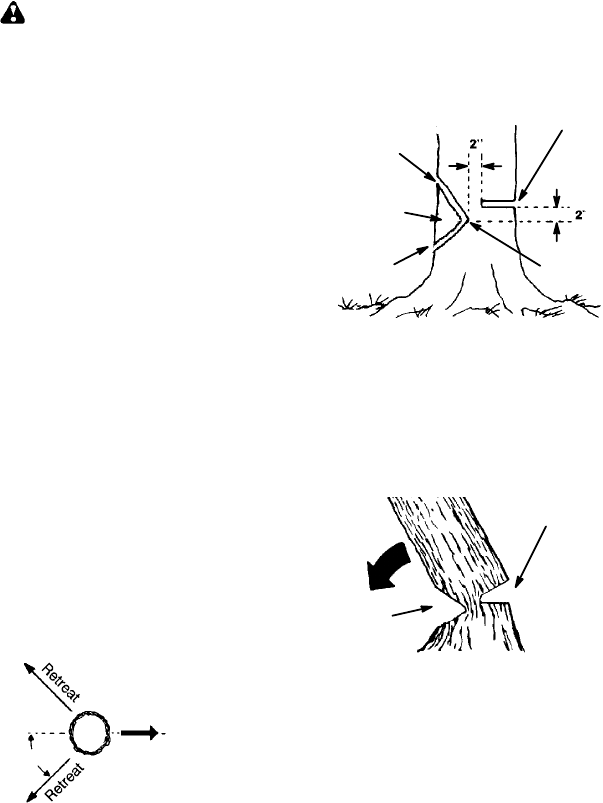
11
S Release the throttle trigger as soon as
the cut is completed, allowing the en-
gine to idle. If you run the saw at full
throttle withouta cutting load,unneces-
sary wear can occur to the chain, bar,
and engine. It is recommended that
the engine not be operated for lon-
ger than 30 seconds at full throttle.
S Toavoidlosingcontrolwhen c utis com-
plete,donot putpressureonsaw atend
of cut.
S Stop the engine before setting the saw
down after cutting.
TREE FELLING TECHNIQUES
WARNING: Check for broken or
dead branches which can fall while cutting
causing serious injur y. Donot c utnear build-
ings or electrical wires ifyou donot know the
direction oftree fall, norcut atnight sinceyou
will not be ale to see well, nor during bad
weather such asrain, snow ,or strong winds,
etc. If the t ree makes contact with any utility
line, the utility company should be notified
immediately .
S Carefully planyour sawingoperation inad-
vance.
S Clearthework area. Youneeda cleararea
all around thetree so y oucan havesecure
footing.
S Study the natural conditio ns that can cause
the tree to fall in a particular direction.
Natural conditions that can cause a tree to
fall in a particular direction include:
S The wind direction and speed.
S The lean of the tree. The lean of a tree
might not be apparent due to uneven or
sloping terrain. Use aplumb or level to de-
termine the direction of tree lean.
S W eight and branches on one side.
S Surrounding trees and obstacles.
Look for decay and rot. If the trunk is rotted, it
can snap and fall toward the operator. Check
for broken or dead branches which can fall on
you while cutting.
Make sure there is enough room for the tree to
fall. Maintain a di stance of
2-1/2 tree lengths
from the nearest person or other objects. En-
gine noise can drown out a warning call.
Remove dirt, stones, loose bark, nails, staples,
and wire from the tree where cuts are to be
made.
Plan aclear re treat pathto therear anddiag-
onal to the line of fall.
Direction of Fall
45_
Plan a clear retreat path
FELLING LARGE TREES
(6 inches (15 cm) in diameter or larger)
The notch method is used to fell large trees.
A not chis cut onthe sideof thetreein t hede-
sired direction of fall. After a felling cut is
made on the opposite side of tree, the tree
will tend to fall into the notch.
NOTE: If the tree has large buttress roots,
removethem beforemaking thenotch. If us-
ing saw to remove buttress roots, keep saw
chain fromcontacting groundto preventdull-
ing of the chain.
NOTCH CUT AND FELLING THE
TREE
S Make notch cut by cutting the top of the
notch first. Cut through
1/3 of the diameter
ofthetree. N extcompletethe notchby cut-
ting the bottom of the notch. See illustra-
tion. Once the notch is cut remove the
notch of wood from the tree.
Notch
First cut
Second cut
Final (felling) cut here, 2 inches
(5 cm) above center of notch.
Hinge
S After removing the cutout of wood, make
the felling cut on the opposite side of the
notch. This is done by making a cut about
two inches (5 cm )higher thanthe center of
the notch. This will leave enough uncut
wood bet weenthe fellingcut andthe notch
to form a hinge. T his hinge will help pre-
vent thetreefromfalling inthe wrongdirec-
tion.
Closing of
notch
Hinge holds tree on stump and helps
control fall
Opening
of felling
cut
NOTE: Before felling cut is complete, use
wedges to open the cut when necessary to
controlthedirectionof fall. To avoidkickback
and chain damage, use w ood or plastic
wedges, but never steel or iron wedges.
S Bealerttosignsthatthetreeisreadytofall:
cracking sounds, widening of the felling cut,
or movement in the upper branches.
S As tree starts to fall, stop saw , put itdown,
and get away quickly on your planned re-
treat path.


















